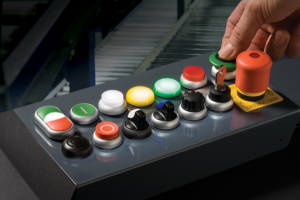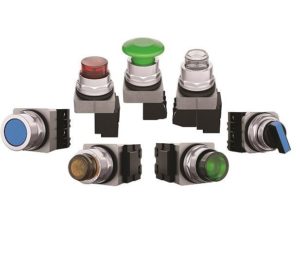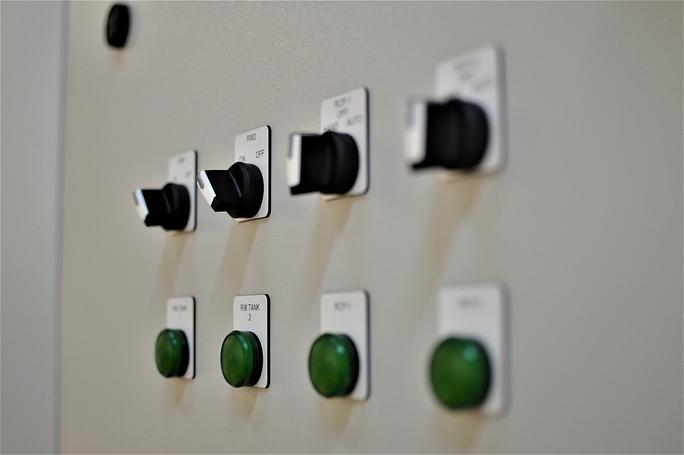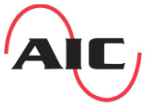Applied Industrial Controls, Inc. can provide a variety of pilot devices at a competitive price, or we can help eliminate these devices in your system and supply a touch screen HMI for complete operational control. Get in touch with us today to learn more.

What Are Pilot Devices?
Pilot devices are used in many applications to enable communication between humans and equipment. This communication allows operators to understand how equipment and machines function, which allows proper operation and can eliminate catastrophic failures, costly repairs or replacements, and process downtime. Examples of pilot devices include:- push buttons – Simple devices that perform a single function such as on/off
- Toggle Switches – More durable single function switch that can also reduce accidental activation
- Selector Switches – Allows for the selection of multiple functions using a single rotating dial
- Rocker Switches – Have a clean aesthetic and identify function by light or graphics
- Emergency Stop Buttons and switches – These devices are color-coded and designed for integration into safety circuits and act as emergency stop functions
- Indicator Lights – Lights that identify the status of a function
- Signal Towers – Also called stack lights, provide 360-degree identification of the status of a function and have color and pattern options
- Buzzers and Audible Alarms – These audible signaling devices often signal faults, alarms, timers, warnings, or starting and stopping operations
Should I Choose an M22 vs. M30 Pilot Device?
When choosing between an M22 and an M30 pilot device, it's important to understand the application requirements and consider all features of each device so that the most effective option is selected. From ergonomic design to multi-color indicating lights, these devices are of high-quality construction and used in a variety of industries.
Comparing the M22 and M30 push button devices, some main features of each to consider:
Both M22 and M30
- Flat connections for space savings, with indicating lights
- Traditional connections with indicating lights
- Multi-color indicating lights
- Spring-cage or screw terminal blocks
- Modular construction
- Durable
- Stackable contact blocks
- Feasible and economical inventory management
- CSA, CE, UL, and RoHs standards compliance
- Easy installation
M22
- Plastic construction with a variety of bezel color options
- Smaller, more compact size
- Multiple aesthetic design options for raised or flat designs
- Lower cost
M30
- Compatible with flat contact blocks and indicating lights
- Compatible with existing M22 contact blocks and indicating lights
- Flat design
- More durable and reliable
- Modern and sleek appearance with stainless steel and chrome bezel options
- Vandalism protection
- NEMA 4X options
- AFX mounting system with push-in terminals
Worldwide recognition and acceptance


Can You Supply Prefabricated Enclosures for M22 and M30 Pilot Devices?
Prefabricated enclosures (link enclosures page) for M22 and M30 pilot devices are common in many different applications. These canned solutions will sufficiently work within a system for housing push buttons, switches, and indicating lights. The M22 and M30 pilot devices have many options available for push button devices. With ergonomic designs, multi-color housings, and environmental seal ratings, these enclosures are constructed of high-quality plastics or metals and can be used in a variety of industries and have many functionalities.
Why Go From Physical Buttons to a Touch Screen HMI?
Touch screen HMIs are the most common form of information transfer and control for complex industrial control panels. Because of their popularity and straightforward operation, HMIs are becoming more prominent in industrial settings and replacing physical controls. HMI touch screens are simple to interpret and user-friendly. They are available in many sizes and have high resolution. They can have custom security access set up for different users, and they have many customizable functions that are not possible with physical controls. Switching from physical controls to an HMI is very economical, reducing labor and material costs. If the system currently uses a PLC, the switch can often provide immediate cost savings and introduce new, market differentiating features.
Applied Industrial Controls Inc. can assist with enabling your system to interact with human operators simply and cost-effectively. If you need low-cost pilot devices or want to achieve the benefits of converting physical push buttons to an HMI display, get in touch with us today.

MANUFACTURERS CERTIFICATIONS

